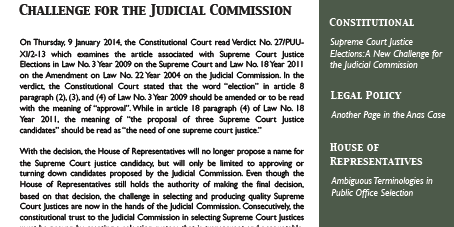Constitutional Court
Supreme Court Justice Elections: A New Challenge for the Judicial Commission
On Thursday, 9 January 2014, the Constitutional Court read Verdict No. 27/PUU-XI/2-13 which examines the article associated with Supreme Court Justice Elections in Law No. 3 Year 2009 on the Supreme Court and Law No. 18 Year 2011 on the Amendment on Law No. 22 Year 2004 on the Judicial Commission. In the verdict, the Constitutional Court stated that the word “election” in article 8 paragraph (2), (3), and (4) of Law No. 3 Year 2009 should be amended or to be read with the meaning of “approval”. While in article 18 paragraph (4) of Law No. 18 Year 2011, the meaning of “the proposal of three Supreme Court Justice candidates” should be read as “the need of one supreme court justice.”
With the decision, the House of Representatives will no longer propose a name for the Supreme Court justice candidacy, but will only be limited to approving or turning down candidates proposed by the Judicial Commission. Even though the House of Representatives still holds the authority of making the final decision, based on that decision, the challenge in selecting and producing quality Supreme Court Justices are now in the hands of the Judicial Commission. Consecutively, the constitutional trust to the Judicial Commission in selecting Supreme Court Justices must be proven by creating a selection system that is transparent and accountable. (FN)
Legal Policy
Another Page in the Anas Case
On the second week of January, the public’s attention was turned towards the circus during the summoning and arrest Democrat Party former chairman, Anas Urbaningrum,by the Corruption Eradication Commission (KPK). Many opinions were raised which in effect make Anas’s case was heavily loaded with political content, whereas the the main problem largely lies on legal issues. Urbaningrum was suspected receiving gratification as large as Rp. 2,21 billion; revealed as facts during the trial of Deddy Kusdinar, the commitment-maker official on the Hambalang sports facility project.
On the other hand, facts in this case were presented in such political manner by Urbaningrum’s camp; much of those facts are obscured enough to drag commissioner to the case.
Even so, the Corruption Eradication Commission should be put into cautionary note since establishing Urbaningrum as one of the suspect in Hambalang case. It has already taken 11 months from his establishment as a suspect until his incarceration. Even so, this cannot be fully blamed on the Corruption Eradication Commission since of Law No. 30 Year 2002 on the Corruption Eradication Commission and Law No. 8 Year 1981 on the Criminal Procedure Code does not regulate status restrictions of a suspect. The Criminal Procedure Code merely regulate that the suspect obtain rights in order for their case to be immediately decided upon, without regulating on how long the period of settlement will be. Another issue is the examination summons by the Corruption Eradication Commission o Urbaningrum which contains the clause “the Hambalang Project and other projects”. In accordance to Article 51 letter a and Article 112 of the Criminal Procedure Code, the suspect has the right to be clearly notified in a manner understood by the suspect on what has been alleged since the start of their time of inspection. Examination summons in principle should contain three elements; (i) valid, i.e. when the summoning party is authorized for that matter, (ii) worthy, i.e. reasonable deadline and examination period, and (iii), clear, i.e. relating to what information will be requested of the suspect.
This has become a reason why Anas Urbaningrum’s party has not attended examinations twice. Johan Budi, spokesman of the Corruption Eradication Commission, stated that there have been legal remedies towards this in the form of pre-trials during the process. But it should be noted that according to Article 77 of the Criminal Procedure Code, pre-trial objects are of a limited nature and are only towards the validity of the arrest, detention, termination of the investigation or termination of the prosecution, as well as the compensation and or rehabilitation of a person whose case has been discontinued at a investigation or prosecution level. Perhaps it’s only a matter of judicial administration, but amid the attacks towards its credibility, the Corruption Eradication Commission procedures shouldn’t be compromised by petty details such this. (MSG)
House of Representatives
Ambiguous Terminologies in Public Office Selection
Based on the mandate of the 1945 Constitution, the House of Representatives has the authority to conduct public official selections. But according to various laws, there are too many terminologies use to describe the process of selecting public officials Such differences using could cause misinterpretations during implementations. The fact is there is no rule which explains process and implementations on the concept of public official selections at the House of Representatives;.
The following are the different terms use of the House of Representatives on selecting public officials; all are mentioned in the constitution, laws and House of Representatives Standing Orders:
|
1945 Constitution |
Laws |
Standing Orders |
|
Consideration |
Consideration |
Consideration |
|
Approval |
Approval |
Approval |
|
Submission |
Submission |
Submission |
|
|
Election |
|
|
|
Appointment |
|
|
|
Proposal |
|
|
|
Consultation, etc. |
|
The Constitutional Court Decision No. 27/PUU-XI/2013 decided on articles related to the election of Supreme Court Justices in Law No. 3 Year 2009 on the Supreme Court and Law No. 18 Year 2011 on the Amendment of Law No. 22 Year 2004 on the Judicial Commission states that the word “election” should be amended or read with the meaning of “approval”. In this case, the House of Representatives no longer conduct elections, but only give approval towards Supreme Court Justice candidates proposed by the Judicial Commission. This precedent should not only be followed by amendments towards the two mentioned Laws (Law on the Supreme Court and Law on the Judicial Commission), but a regulation which explains in detail the meaning and stages of implementation from each terminology should follow also. The amendments towards the Law on the People’s Consultative Assembly, House of Representatives, House of Regional Representatives and Regional House of Representatives (MD3 Law) and House of Representatives Standing Orders can be considered as an entrance to such alterations. (SMR)

